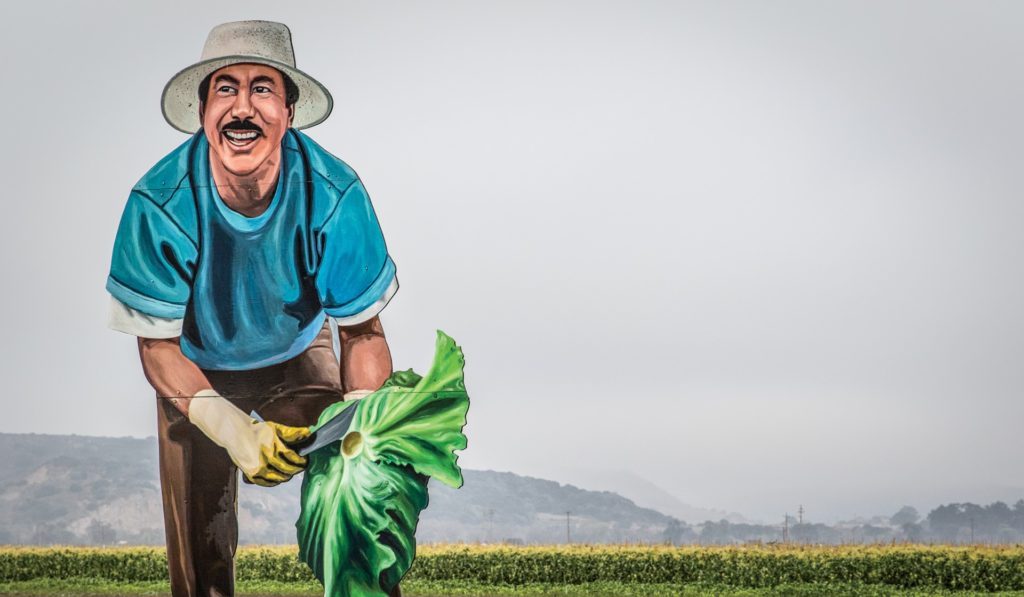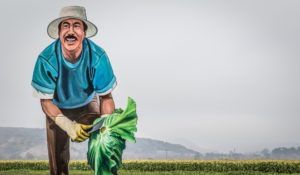A Farmer’s Perspective: Immigrant Workers and Their Critical Role
The Farm is a special place in California’s Salinas Valley. Including a 15-acre demonstration plot situated just off busy Highway 68, it’s peppered with large murals by artist John Cerney that depict the largely immigrant labor force responsible for making...

A Farmer’s Perspective: Immigrant Workers and Their Critical Role
The Farm is a special place in California’s Salinas Valley. Including a 15-acre demonstration plot situated just off busy Highway 68, it’s peppered with large murals by artist John Cerney that depict the largely immigrant labor force responsible for making...
The Farm is a special place in California’s Salinas Valley. Including a 15-acre demonstration plot situated just off busy Highway 68, it’s peppered with large murals by artist John Cerney that depict the largely immigrant labor force responsible for making Monterey County “the Salad Bowl of the World.” Begun in the 1920s by Chris Bunn’s grandfather, The Farm and surrounding farmland benefit from Monterey County’s long growing season, which runs March through November and allows the valley’s producers to double crop.
“It’s an alluvial valley,” says Bunn. “It doesn’t get really hot or really cold.” It’s the ideal climate for growing an array of crops, and the Bunns grow four different varieties of produce over the entirety of their 300-acre farm. At the farmstead, where they maintain a “demonstration farm” for visitors and school groups, they produce 35 different crops, the big ones being corn, tomatoes, pumpkins and strawberries.
The Bunns farm both owned and leased land. “Everything here is farmed patchwork,” says Bunn. “Nobody farms contiguous like in the Midwest.” That’s because land is so hard to come by. In the Salinas Valley, it’s not unusual to see producers cultivating land almost up to the doorstep of their homes.
“If you couldn’t double-crop this ground,” Bunn adds, “it wouldn’t be worth it.” Adding to the value of what’s grown on the land, Bunn and family are organic farmers (certified by California Certified Organic Farmers) and have been for nearly three decades. “It’s not a philosophical choice,” says Bunn. “It’s about economics.”
Smart decisions are a hallmark of Bunn’s operation, including his choice of farm equipment. He uses three Challenger® tractors on his farm, all purchased in 2009. “Soil compaction in our Blanco adobe soil conditions is extremely important,” he says, “and the Challengers all float across our fields with great comfort and speed like ships on the sea!” He also appreciates their power, fuel efficiency and ease of use in many roles on the farm.
Despite a popular misperception, cheap labor is not what drives this region of the country to employ so many immigrants. What does spur the hiring of immigrant workers is that most longtime residents in the area don’t want to work in the fields.
Bunn says strawberry pickers in the valley, for example, typically earn $1.20 per case. “A good picker can pick 100 cases a day,” he says. That translates into a wage of $120 a day during harvest season. It’s “back-breaking work,” Bunn acknowledges, and farmers like him have suggested that’s why native-born citizens aren’t inclined to apply for it.
For Bunn, immigrant labor is critical, as it is for many producers in California and elsewhere. “Labor is one of the most expensive and important inputs for agriculture [here],” he remarks. “With commodity crops, it takes one person per 1,000 acres; for us, it’s one to two people per 10 acres.”
For video, photos and more of the story, visit A Farmer’s Perspective: Immigrant Workers and Their Critical Role.



